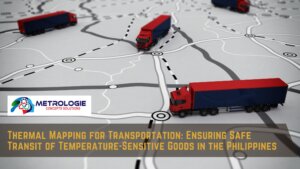Discover the significance of thermal mapping applications in pharmaceutical warehousing for ensuring product quality and compliance. Learn how these technologies optimize storage conditions, streamline operations, and enhance regulatory adherence.
Introduction
In the dynamic landscape of pharmaceutical warehousing, precision and compliance are paramount. Thermal mapping applications play a pivotal role in ensuring that products remain within specified temperature ranges, safeguarding their integrity and efficacy. This article delves into the multifaceted applications of thermal mapping technologies, exploring their significance in maintaining optimal storage conditions and regulatory adherence within pharmaceutical facilities.
Understanding Thermal Mapping
Thermal mapping forms the cornerstone of temperature monitoring in pharmaceutical warehousing. It involves the systematic collection and analysis of temperature data across different zones within a storage facility.
Importance of Temperature Monitoring
Maintaining consistent temperatures is crucial for preserving the efficacy and stability of pharmaceutical products. Temperature excursions can compromise product quality, leading to financial losses and regulatory non-compliance.
Compliance with Regulatory Standards
Thermal mapping facilitates compliance with stringent regulatory requirements imposed by bodies such as the FDA and EMA. By ensuring adherence to specified temperature ranges, pharmaceutical companies mitigate the risk of product degradation and regulatory penalties.
Technological Advancements in Thermal Mapping
The evolution of thermal mapping technologies has revolutionized temperature monitoring practices in pharmaceutical warehousing.
Automated Data Logging Systems
Advanced data logging systems automate temperature data collection, enhancing efficiency and accuracy while reducing manual errors. These systems enable real-time monitoring and alerting, allowing for prompt intervention in the event of temperature deviations.
Wireless Sensor Networks
Wireless sensor networks offer unparalleled flexibility in temperature monitoring, allowing pharmaceutical companies to monitor conditions in real-time across expansive storage facilities. These networks enable proactive temperature management and facilitate compliance with regulatory requirements.
Benefits of Thermal Mapping Applications
Thermal mapping applications offer a myriad of benefits to pharmaceutical companies, ranging from cost savings to enhanced regulatory compliance.
Improved Product Quality
By maintaining optimal storage conditions, thermal mapping applications mitigate the risk of temperature excursions, preserving product quality and efficacy. This translates to reduced product wastage and enhanced customer satisfaction.
Enhanced Operational Efficiency
Streamlined temperature monitoring processes, facilitated by thermal mapping applications, optimize warehouse operations and minimize resource expenditure. Real-time data insights empower warehouse managers to make informed decisions, thereby improving overall efficiency.
Regulatory Adherence
Thermal mapping applications enable pharmaceutical companies to demonstrate compliance with regulatory standards governing product storage and distribution. By implementing robust temperature monitoring protocols, companies mitigate the risk of regulatory penalties and safeguard their reputation.
Challenges and Considerations
While thermal mapping applications offer significant benefits, certain challenges must be addressed to maximize their effectiveness.
Calibration and Validation
Ensuring the accuracy and reliability of temperature monitoring equipment through regular calibration and validation is essential for maintaining data integrity and regulatory compliance.
Data Security
Safeguarding temperature data from unauthorized access or tampering is imperative to maintain data integrity and protect sensitive information from breaches.
Integration with Existing Systems
Seamless integration of thermal mapping technologies with existing warehouse management systems is essential for maximizing efficiency and minimizing disruptions to operations.
Future Trends in Thermal Mapping
The future of thermal mapping in pharmaceutical warehousing is poised for further innovation and integration with emerging technologies.
IoT Integration
Integration with the Internet of Things (IoT) promises to revolutionize temperature monitoring practices by enabling real-time data analysis and predictive maintenance.
Artificial Intelligence
The integration of artificial intelligence algorithms holds the potential to enhance predictive capabilities and optimize temperature control strategies in pharmaceutical warehousing.
Blockchain Technology
Blockchain technology offers immutable and transparent data storage solutions, enhancing the security and traceability of temperature data in pharmaceutical supply chains.
Thermal Mapping Applications in Pharmaceutical Warehousing
Thermal mapping applications encompass various facets of pharmaceutical warehousing, each serving a specific purpose in ensuring product quality and regulatory compliance.
Cold Chain Management
Thermal mapping facilitates precise monitoring of temperature-sensitive products throughout the cold chain, ensuring adherence to stringent temperature requirements from manufacturing to distribution.
Stability Testing
Stability testing, a critical aspect of pharmaceutical quality control, relies on accurate temperature monitoring to assess product shelf-life and degradation rates under various storage conditions.
Environmental Monitoring
Thermal mapping applications extend beyond temperature monitoring to encompass environmental factors such as humidity and light exposure, which can also impact product stability and quality.
FAQs (Frequently Asked Questions)
How often should thermal mapping be conducted in pharmaceutical warehouses?
Thermal mapping should be conducted at regular intervals, typically annually, or whenever there are significant changes to warehouse layout or equipment.
Is thermal mapping required for all pharmaceutical storage areas?
Yes, thermal mapping is essential for all storage areas where pharmaceutical products are stored, including warehouses, cold rooms, and refrigerators.
What are the consequences of failing to conduct thermal mapping?
Failing to conduct thermal mapping can lead to temperature excursions, compromising product quality, regulatory compliance, and patient safety.
How long does a typical thermal mapping study take?
The duration of a thermal mapping study depends on factors such as the size of the facility and the complexity of the storage environment but typically ranges from several days to a few weeks.
Can thermal mapping data be used to optimize warehouse layout?
Yes, thermal mapping data can provide insights into temperature variations across different zones within a warehouse, informing decisions related to warehouse layout and product placement.
Are there regulations governing thermal mapping in pharmaceutical warehousing?
Yes, regulatory agencies such as the FDA and EMA have established guidelines for temperature monitoring and thermal mapping in pharmaceutical storage facilities.
Conclusion
Thermal mapping applications are indispensable tools for ensuring the quality, safety, and compliance of pharmaceutical products within storage facilities. By leveraging advanced technologies and adhering to regulatory standards, pharmaceutical companies can optimize their warehousing operations and safeguard the integrity of their products.




